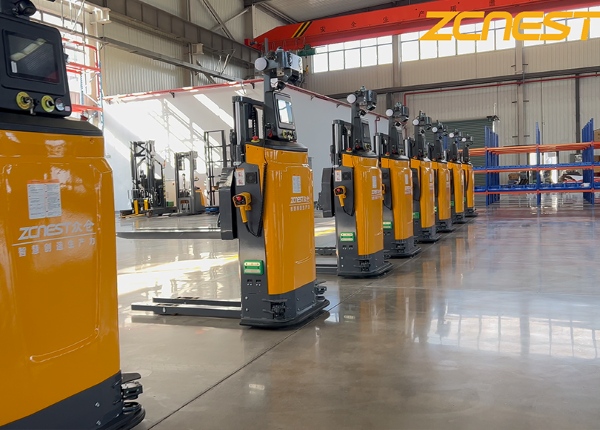An Auto Guided Vehicle is a mobile robot used to transport materials within a facility without human intervention. Guided by various technologies such as magnetic tape, laser
sensors, or vision-based navigation, AGVs follow pre-defined paths or dynamically planned routes to perform tasks like:
Pallet transport
Finished goods delivery
Component feeding to assembly lines
Waste material removal
These systems are programmable, safe, and scalable—making them ideal for environments where precision and consistency are critical.

AGVs function by combining onboard navigation systems, real-time communication, and fleet control software. A typical AGV setup includes:
Navigation System: Laser, magnetic, QR code, or natural feature-based guidance helps the AGV understand its position.
Obstacle Detection: Equipped with LiDAR, proximity sensors, or bumpers, AGVs stop automatically when humans or obstacles are in their path.
Vehicle Controller: This is the AGV’s “brain,” responsible for driving, steering, lifting (if needed), and communication with the central system.
Battery System: Most AGVs run on rechargeable lithium-ion batteries and may include automated charging functions.
Depending on the task and environment, AGVs come in several forms:
| AGV Type | Primary Use |
|---|---|
| Tow Vehicles | Pull carts or trains of materials |
| Unit Load AGVs | Transport pallets or containers |
| Forklift AGVs | Replace manual forklifts |
| Conveyor AGVs | Integrated with belts to move items |
| Custom AGVs | Designed for specific industrial tasks |
Labor Cost Reduction
AGVs operate 24/7, reducing dependency on manual labor in repetitive or dangerous tasks.
Improved Safety
With built-in safety protocols and sensors, AGVs reduce workplace accidents, especially in high-traffic or hazardous areas.
Operational Efficiency
Through intelligent scheduling and route optimization, AGVs minimize idle time and boost process flow.
Scalability
As business grows, additional AGVs can be integrated into existing systems with minimal disruption.
Data Collection & Integration
AGVs provide real-time data that can be linked to ERP, WMS, or MES platforms, enhancing visibility and decision-making.
| Industry | Application Example |
|---|---|
| Automotive | Engine transport, body panel movement |
| Electronics | PCB and component delivery to cleanroom zones |
| E-commerce & Retail | Warehouse picking and order fulfillment |
| Food & Beverage | Raw material and packaging transport |
| Pharmaceuticals | Sterile, hands-free material movement |
Before implementing an AGV solution, consider the following:
Facility Layout: Does the site support AGV paths? Any ramps, elevators, or narrow aisles?
Payload Requirements: Ensure the selected AGV can handle maximum loads with stability.
Integration Needs: Will the AGV system connect with your existing warehouse or production software?
Traffic Volume: High-density operations may require advanced fleet coordination software.
Budget & ROI: Balance short-term investment with long-term efficiency gains.
Autonomous Mobile Robots (AMRs): AGVs with higher AI capabilities, able to navigate dynamic environments.
Hybrid Systems: Integration of AGVs with robotic arms or conveyors for multi-task automation.
Cloud-Based Management: Remote diagnostics, predictive maintenance, and centralized control.
Sustainability: Energy-efficient models with regenerative braking and smart charging cycles.
Auto Guided Vehicles are no longer a luxury—they are a necessity for manufacturers and logistics providers aiming for precision, speed, and adaptability. As industries continue to embrace automation, AGVs will remain central to achieving streamlined operations and sustainable growth.
By understanding their capabilities and aligning them with your unique operational needs, an AGV system can become one of your most reliable assets in building a smart, connected, and future-ready enterprise.